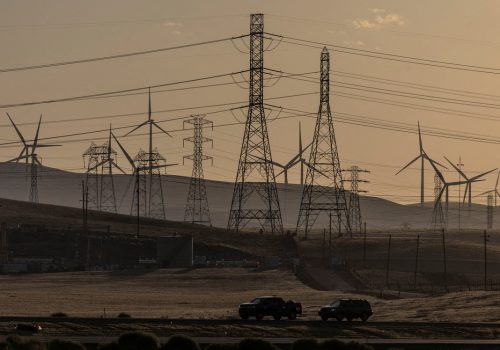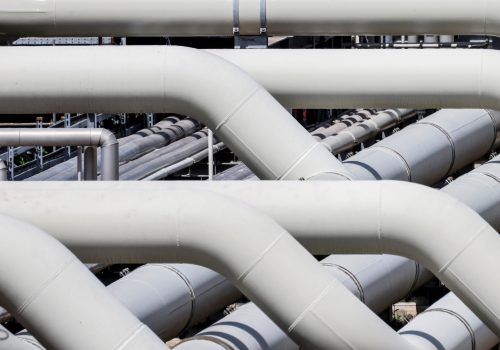Carbon removal is a once-in-a-generation opportunity to reduce the risks of overshooting global warming targets
The Climate Overshoot Commission—an independent group of experts, policymakers, and civil society leaders who work on exploring strategies to reduce risks should global warming goals be exceeded—just released their highly anticipated report on Reducing the Risks of Climate Overshoot, which underscores the pressing need for immediate action to mitigate the escalating risks of climate change. As the world contends with the likely prospect of “climate overshoot”—failing to meet the Paris Agreement goal of limiting global warming to 1.5 degrees Celsius by 2100—the potential consequences for humanity are becoming increasingly dire. While the entire planet will be affected, the impact will be disproportionately skewed toward the most vulnerable, particularly in the least industrialized countries, who stand to suffer the most despite contributing the least to the problem. But as the Commission reminds us, none of these consequences are inevitable.
Enhancing carbon dioxide removal efforts
To address the challenges posed by climate overshoot, one of the foundational strategies recommended by the Climate Overshoot Commission is the rapid expansion of carbon dioxide removal (CDR) technologies. These technologies offer a crucial pathway to achieving net-zero emissions and minimizing the extent and duration of any overshoot. However, CDR should not be used as an excuse for inaction or delaying other emissions mitigation efforts. CDR encompasses various methods for removing carbon dioxide from the atmosphere, including both nature-based and engineered approaches. While these methods vary in terms of their risks and benefits, they share a common goal: to store carbon emissions securely and permanently, thus mitigating the impacts of climate change while emissions are concurrently reduced.
These recommendations emboldened by the state of our rapidly warming planet come on the heels of the recent announcement by the US Department of Energy to fund selected projects through the first round of grants for the Direct Air Capture (DAC) Hubs program. With $1.2 billion for two projects along the Gulf Coast region, this is the world’s largest investment in engineered carbon removal to date. In addition to these two projects in Texas and Louisiana, the Department of Energy also selected nineteen additional projects for award negotiations of almost one hundred million dollars that will support front-end engineering and design and feasibility studies for potential DAC hubs across the nation. This investment is critical for commercial demonstration of DAC and building necessary project management experience in this new sector. This “hubs” model can enable large-scale deployment and reduce overall costs of DAC by locating multiple facilities in a certain region where they can share infrastructure.
This historic investment comes a few months before the United Nations Conference of the Parties (COP28) in Dubai, United Arab Emirates (UAE), where the first global target for carbon management will be announced. Earlier this year, the United States, along with ten other countries, announced the Carbon Management Challenge. This global initiative supports the deployment of large-scale carbon sequestration technologies as a climate mitigation tool. Participating countries are expected to announce contributing measures and specific targets at COP28. This initiative and the UAE’s recent efforts to become a regional leader in carbon management will make COP28 a pivotal moment for this emerging sector.
Because climate mitigation efforts to date have been insufficient, there is a need for scaling carbon dioxide removal technologies to address legacy emissions in the atmosphere and complement emissions reduction efforts, especially from hard-to-abate sectors. Different models developed by scientific bodies across the world—including the Intergovernmental Panel on Climate Change, the National Academies of Sciences, Engineering, and Medicine, the International Energy Agency, and the International Renewable Energy Agency—highlight the potential for carbon management technologies to achieve the target of limiting global warming to 1.5 degrees Celsius by the end of the century and avoiding a climate overshoot scenario. While the effects of carbon management vary across these different models, they all envision some levels of contributions that are inversely proportional to our emission reduction efforts. Simply, the more we manage to reduce emissions, the less we will need carbon management solutions and vice versa. However, these technologies should be viewed as complementary tools, rather than a substitute for mitigation technologies.
How does Direct Air Capture work?
DAC removes dilute carbon dioxide from the atmosphere via chemical bonding. The process of removing carbon dioxide from the atmosphere into solid storage is called a sink, and while many natural carbon sinks exist (e.g., plants, soil, and oceans), DAC processes expedite the gaseous to solid conversion of carbon dioxide. Currently, there are two main types of DAC being scaled: a liquid-based method, called chemical liquid solvent, and a solid-based method, called chemical solid sorbent DAC. While there are technical differences between the two methods, they operate under a similar concept: removal of carbon dioxide from the atmosphere by contact with a basic solution (chemical liquid solvents) or a basic modified surface (chemical solid sorbents). Once captured via a chemical bond, the carbon dioxide can subsequently be released from the capture media through the application of heat, producing high-purity carbon dioxide gas that can be transported to storage sites or industrial plants for use. After the carbon dioxide is released, the capture media can be used again for further carbon dioxide removal.
Long-term carbon sequestration and the need for monitoring, reporting, and verification processes
As we continue to develop methods to sequester atmospheric carbon, the primary focus must remain on reducing carbon emissions. As the concentration of carbon dioxide in the Earth’s atmosphere has increased, a key concern and focus has been on existing nature-based and engineered sequestration efforts, or sinks, to ensure that they are not reversed or slowed down (e.g., warming oceans, melting permafrost, and deforestation). To ensure durable sequestration of carbon emissions, concurrent approaches to removing carbon dioxide from the atmosphere will be necessary, such as DAC, biomass with carbon removal and storage, soil carbon sequestration, ocean carbon sequestration, reforestation, and enhanced weathering. Each of these types of carbon sequestration methods have their own advantages and disadvantages, including costs, maturity of method, energy requirements, land use, and environmental impacts.
The length of time that carbon can be sequestered varies depending on the approach. Though several factors impact the durability of sequestering carbon emissions, understanding the limitations is important when deciding which type of carbon sequestration to employ. Soils and biomass store carbon for shorter periods of time, while oceans and engineered solutions store carbon long-term (on the scale of hundreds to thousands of years) and even permanently. Additionally, nature-based and engineered sinks are subject to direct and indirect factors and will heavily rely on accurate long-term monitoring to mitigate the impact of external disturbances.
Effective and transparent monitoring, reporting, and verification (MRV) processes are essential for ensuring the credibility of carbon removal and is an area in which the international community should continue pursuing governance approaches. By ensuring that the amount of carbon removed is accurate and verifiable, MRV processes can help build trust and confidence in carbon removal projects, identify and address risks, and support decision-making. A lesson on trust can be learned from the controversial attempts to hold private industries accountable for their emissions by employing carbon offset credits. Therefore, it is integral that robust methods of MRV are set into place to ensure that the public trusts in the delivery of the technology.
The importance of national policies and global collaboration
Governments have recently been utilizing their policy levers to underwrite the deployment of CDR technologies. In the United States, the Inflation Reduction Act (2022) contains a significant boost for carbon removal efforts by extending the 45Q tax credit for carbon sequestration and adding an enhanced credit for DAC. Policy updates implemented in Europe, the United Kingdom, Canada, and Japan, aimed at incentivizing emerging carbon removal technologies like DAC, are crucial steps toward scaling up these innovative solutions to meet the goal of limiting global warming to 1.5 degrees Celsius. Also, public procurement of low-carbon products and materials can play an important role in catalyzing new markets for carbon removal. The increased financial incentives and accessibility these types of policies offer could exponentially accelerate DAC progress and underscores the global recognition of DAC’s potential contribution to emissions reduction.
Global collaboration is imperative to address the challenges of climate change. It is essential for effective carbon management—the principal way to curb climate change. No single country can effectively reduce emissions or develop and deploy carbon management technologies in isolation. To maximize the impact in the short to medium term, the Climate Overshoot Commission strongly recommends international cooperative efforts to jointly fund and implement CDR technologies on a global scale. Through active cooperation, countries can pool their resources, knowledge, and technology to expedite the deployment of CDR technologies. Furthermore, the establishment of common standards and regulations will ensure the effectiveness and efficiency of carbon management efforts. Article 6 of the Paris Agreement offers a framework for international cooperation on carbon management, encompassing activities such as joint implementation, emissions trading, and the development of carbon markets. By effectively utilizing Article 6, countries can accelerate the development and deployment of carbon management technologies and help to mitigate climate change.
COP28: A pivotal moment for carbon management
COP28 will be the conclusion of the first Global Stocktake, which will show the emissions gap clearly and demonstrate why it is necessary to collaborate on carbon management at a global scale to reach global climate targets. This collaboration would require effective governance and a robust, globally applicable method for tracking and reporting carbon management.
While COP28 will be an unprecedented opportunity to build global momentum, it will probably be one of the toughest tests for carbon management as well. There has already been a growing movement against government support for these technologies, including prominent voices like former US Vice President Al Gore who described carbon management as “a moral hazard” and an excuse for fossil fuel companies to continue emitting carbon.
These criticisms present an opportunity for the delegates at COP28 to come up with strong mitigation actions and a clear roadmap for loss and damage. This will demonstrate to environmental organizations and activists that the COP28 carbon management targets and this year’s historic investments to mitigate climate change are additional methods of arriving at, and not substitutes for, the collective goal of limiting global warming to 1.5 degrees Celsius by 2100. There is undeniably a moral hazard in delaying ongoing mitigation efforts based on the assumption that carbon management will be available in the near future and can scale up relatively quickly. That is why, to gain legitimacy and support from the broad climate community, any carbon management targets that will be announced during COP28 should be in addition to strong mitigation and adaptation actions.
Mahmoud Abouelnaga is a nonresident senior fellow at the Atlantic Council’s GeoTech Center.
Raul Brens Jr. is the deputy director and a senior fellow at the Atlantic Council’s GeoTech Center.
Further reading
Thu, Aug 24, 2023
Transitioning to the clean energy grid: A deep dive into the levelized cost of electricity
Issue Brief By Ken Berlin, Frank Willey
To benefit fully from the lower cost of generating renewables and to achieve a transition to a clean energy system as rapidly as possible, the United States must implement a more efficient planning and permitting process.
Mon, Aug 7, 2023
The on-ramp for hydrogen: The natural gas network
In-Depth Research & Reports By Cynthia Quarterman
This Global Energy Center report examines how blending hydrogen into US gas pipelines can quickly support demand growth for this key technology for US decarbonization objectives. The report provides recommendations for how policymakers can create a favorable regulatory environment to overcome technical obstacles to scaling up hydrogen deployment.
Wed, Jun 28, 2023
Building a biofuels industry in Africa
Issue Brief By
In numerous African nations, the expansion of the biofuels industry could serve as a solution, albeit a partial one, to support the interlocking imperatives of achieving universal access to modern energy services and attaining a high-growth, low-carbon economy.
Image: The world’s largest direct air capture and storage plant that permanently removes CO₂ from the air has opened in Iceland.


